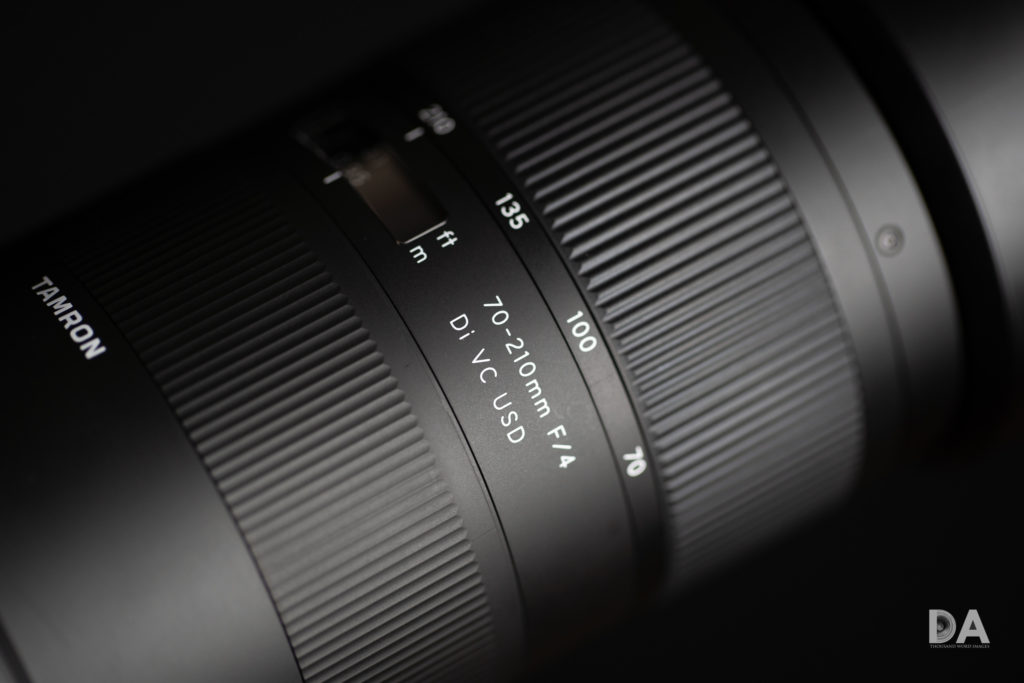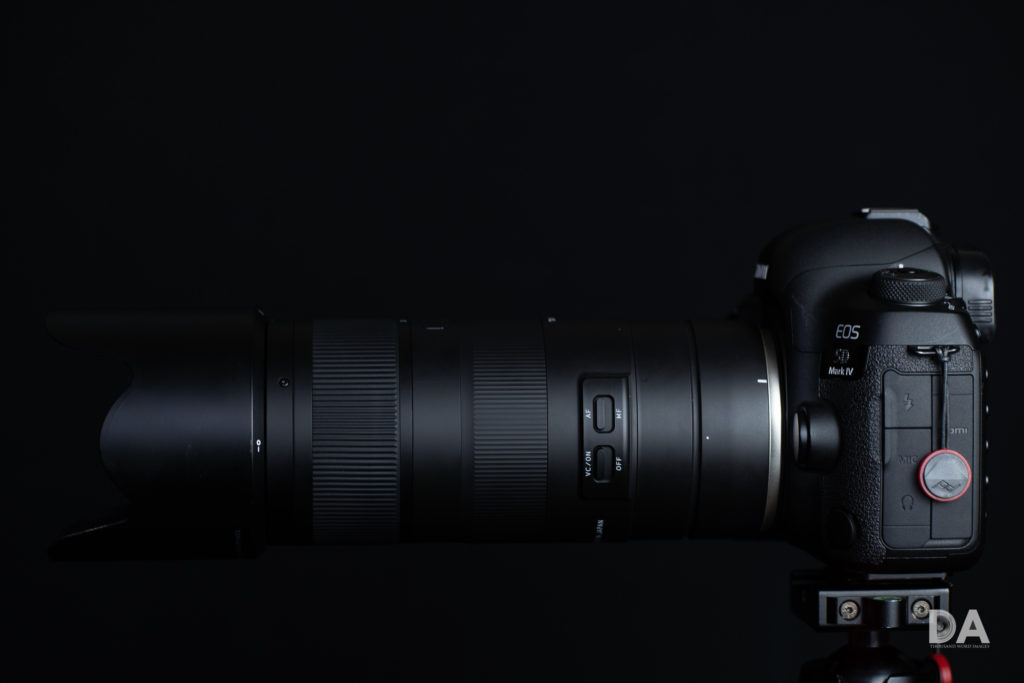Tamron’s last two lens announcements might have created a bit of nostalgia for those familiar with vintage Tamron products. They announced a 28-75mm F/2.8 for Sony FE, and I have a lot of fond memories of using the slightly primitive but optically excellent 28-75mm F/2.8 Tamron lens in a Canon EF mount a number of years ago. The announcement of this lens, the Tamron 70-210mm F/4 Di VC USD (A034), might seem odd to those accustomed to the standard 70-200mm focal length, but those that can remember back to the Tamron Adaptall age might remember a 70-210mm lens from Tamron in that era before most modern camera mounts. Tamron is leveraging its past expertise at these atypical focal lengths to produce modern lenses with a little edge over their competitors. The 70-210mm VC jumps into a market where the first parties have good but aging options, which allows Tamron to be the first to bring modern lens technologies to the category.
An f/4 lens at this focal length bridges the gap between less expensive variable aperture zoom options (like the common 70-300mm f/4-5.6[6.3] variants) and the larger, more expensive f/2.8 options like Tamron’s own excellent 70-200mm F/2.8 VC G2 lens. There are a number of people that want premium optical performance and a constant aperture, but don’t want to deal with the size, weight, and expense of an f/2.8 lens. If this describes you, a lens like this 70-210mm F/4 lens will hit the sweet spot. Not too big, not too expensive, optically excellent, and feature rich.
Tamron has made a number of crucial advances in their lens design on their more premium lenses, and the benefit is that those technologies have trickled down to some of their less expensive options. Tamron’s premium designation is their SP (Super/Superior Performance) line, which spawned a new design language on the SP prime lenses and then on a G2 versions of several of their key zoom lenses (24-70mm F/2.8, 70-200mm F/2.8, and 150-600mm F/5-6.3). Since that new look debuted, I’ve reviewed the 10-24mm VC, the 100-400mm VC, and now this 70-210mm VC lens. These lenses inherit the basic look of the more premium lenses along with a number of their features (weather sealing, Tap-in compatibility, improved focus, improved build and design). The materials are not quite as premium (some engineered plastics are mixed in with metal alloys), but the look and build of the lenses is very nice.
The A034 is a long, fairly slender lens with a very common 67mm front filter thread that is shared with a number of other Tamron lenses. The 70-210mm VC is identical to the Canon 70-200mm f/4L IS in diameter (2.99”/76mm) though just a hair longer at 6.9” (175mm) vs 6.77” (172mm). The physical difference is not enough to be meaningful, though it is worth noting that the Tamron does have that extra 10mm of focal length. Both lenses are internally zooming and focusing, so that length is a constant.
The Tamron is also the heavier lens by a small margin. It weighs in at 1.89 lb (859g), compared to 1.68 lb (760g) for the Canon. This is enough to be noticeable, though probably not in a meaningful way. The bright side, perhaps, is that the heft of the lens might provide some reassurance of the quality of the build.
Tamron has been working at delivering quality levels of weather sealing on lenses across their product line, and the 70-210mm VC is no different. It has sealing at the lens mount, switches, and rings along with an expensive fluorine coating on the front element that resists not only moisture but also things like fingerprints. This helps the front element to be easier to clean and also looks pretty cool when reflecting light.
Tamron employs a consistent design language in their lenses from the past few years. It is sleek and modern, with a satin anodized finish. I really like the look of the lenses and the feel of the switches. The action of the zoom ring is flawless; it moves easily and quickly with no sticking points or rough feel. It has the typical ribbed finish that is easy to grip and use. The zoom ring is closer to the front of the lens, while the manual focus lens will be closer to the camera. There is a distance window in between them.
The manual focus ring is lower profile, with very shallow ribbing. I prefer the look and feel of the zoom ring from an ergonomic perspective, though the focus ring moves smoothly. It just feels, well, cheaper to my touch. It should be noted that Tamron chooses to have its zoom and focus rings move in the “Nikon” direction rather than the Canon direction. Thus the movement of these rings will feel familiar to Nikon shooters but might feel backwards to Canon shooters.
Up front there is a very commonly-sized 67mm filter thread, which is shared across a number of Tamron’s newest lenses (including all the SP primes and the new 100-400 VC lens). There are nine rounded aperture blades that help keep a circular shape even when stopping the lens down to smaller apertures like f/5.6 or f/8.
There are two switches on the side of the barrel. An AF/MF switch (the lens does allow full time manual override of focus) and a VC (Vibration Compensation) ON/OFF switch. There isn’t an option to select different modes for the VC, though it should be noted that you can program in differing behavior for the VC through the optional Tap-in Console accessory. I often elect to employ the “Capture Priority” mode (Mode 3), which does little to stabilize the viewfinder (allowing you to naturally track action) but gives the most effective stabilization to the actual images. If you have shaky hands, however, you may prefer a mode that prioritizes locking down the viewfinder image. Tamron’s VC on this lens is rated at 4 stops. In real world use I didn’t find the VC as effective as Tamron’s best efforts, though it gets high marks for quietness when compared to the older Canon lenses’ IS system.
Unlike the more expensive f/2.8 70-200mm variants, the 70-210mm VC (like the Canon f/4 lens) doesn’t come with a tripod collar. The A034TM is available as a separate accessory, though the advantage of the Tamron collar (compared to the Canon) is that the Tamron collar is Arca-Swiss compatible, meaning that you can easily mount it on most tripods without any need for a quick release plate. It saves time and adds to the flexibility of the lens. If you aren’t a tripod shooter, however, the lens is easily light enough to be handheld for most shooters and isn’t heavy enough to really stress a camera even if mounted on a tripod. You will know if you are a person who needs a tripod collar or not.
One of the great strengths of the 70-210mm VC is its ability to focus down very closely (under 1 meter – 3.12 feet). This allows the lens to have a near-macro like performance with a magnification of 0.32x (1:3.1 reproduction ratio). This easily bests the Canon’s 0.21x. I personally value lenses with good magnification figures as it adds to the versatility to the lens and the kind of shots you can take with it. This is a class-leading performance.
Another thing worth noting is that the 70-210mm VC is compatible with Tamron’s new TCs (teleconverters), which can add to the reach of the lens. The 1.4x teleconverter, for example, will make the lens behave like a 98-294mm f/5.6 lens, which is also a very useful focal range.
The A034 employs Tamron’s USD (Ultrasonic Drive) focus motor, though I found the behavior of the application here somewhat of a hybrid approach. It’s clear that the focus motor has been tweaked to work similarly with both Phase Detect (viewfinder) and Contrast (Live View and/or mirrorless) focus modes. On Canon cameras I found the focus speed and sound of the lens roughly similar either through the viewfinder or when using the LCD screen and Live View. I also found focus behavior to be fairly fast when using the lens via adapter on Sony bodies. The downside of this approach is that traditional viewfinder focus speed wasn’t quite at the level of lenses like the 70-200mm F/2.8 G2, and I did encounter a few more “focus racks” (the lens defocuses before nailing proper focus) than what I would like. It’s possible that a future firmware update might refine this behavior. I made some minor focus adjustments through the Tap-in Console and saw good focus accuracy after doing so.
The lens produces strong images with excellent color rendition and contrast. I found that the sharpness at wide apertures lagged just slightly behind the much more expensive G2 lens in controlled tests, but found that real world results were consistently excellent. The longer focal length allows for nicely defocused backgrounds, and bokeh, for the most part, was quite nice. I did note a little bit of busyness in a few challenging situations, but also thought results were excellent when the lens was used to its strengths. Image sharpness was quite consistent throughout the focal range, with peak sharpness coming in the middle of the focal range. This shot of squirrel as 210mm, wide open, shows that the lens is capable of producing remarkably crisp results.
The lens will show some veiling (loss of contrast) when the sun is in the frame, but fortunately this happens in a very artistic fashion. I found chromatic aberrations to be well controlled and not an issue for field use. There is a mild amount of barrel distortion on the wide end of the frame, and vignette is most strongly pronounced at 210mm, though is easily correctable in post. The shortcomings of the A034 are all mild, while its strengths are significant.
In conclusion, Tamron has demonstrated a consistently ability in recent years to produce a strong zoom lens. They seem to have good instincts on which features to emphasize, and have a good job of creating very well-rounded products that do everything fairly well. The Tamron 70-210mm f/4 Di VC USD is no exception. I can easily remember the days where the cost of a 70-200mm f/2.8 lens was outside my budget and exceeded the tolerances of the amount of weight I wanted to carry, and that is what drove me to purchase and use several of Canon’s 70-200mm f/4 L series lenses (both stabilized and non-stabilized variants). There will undoubtedly be many photographers in a similar situation, and Tamron has done a great job of producing a lens that will meet the actual needs of many photographers while undercutting the price of Canon or Nikon options by a wide margin. Tamron’s industry-leading warranty will help give peace of mind to those considering a third party lens for the first time. If you are a photographer who ascribes to the “less-is-more” philosophy, the A034 costs less, weighs less, and makes less noise in operation while offering up more features, more magnification, and even more focal length. What’s not to like?
About the Author
Dustin Abbott is a full time pastor/part time photographer from Pembroke, Ontario who shoots professionally but primarily for capturing beauty and sharing it with others. www.dustinabbott.net


























Hello Dustin,
Is this lens compatible with Tamron’s Tap-in console? I didn’t see this lens listed on their website. Regardless, I just bought the lens and I took it out to get some shots of friends riding an ATV. I was having issues focusing on my subjects. Most of the time, I am front focusing but I also noticed I was getting significant motion blur even when moving in the direction of their movement. I wonder if the motion blur has to do with the VC (e.g. 3 vs 4)? I also wonder if the front focusing is just an issue with variation with my camera’s body? (Nikon D5300). Any help is appreciated.
Hi Julio, Please see Dustin’s reply as below.
Hi Julio.
Yes, the lens is compatible with the Tap-In Console, and you can make adjustments to both the focus and VC behavior. If panning is your priority, you can set things up accordingly. Even with VC, though, it is important to keep your shutter speed up when trying to “stop” fast action.
I used the Tap In to dial in the focus of my review copy, and it worked well after that.
Dustin